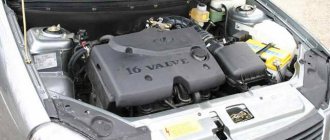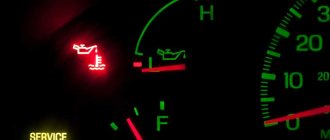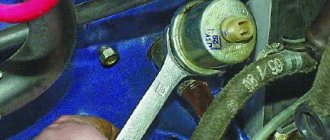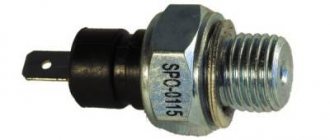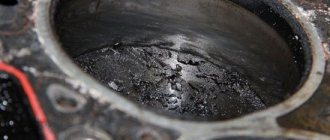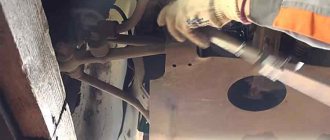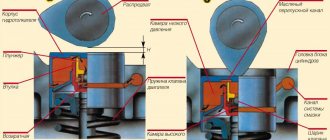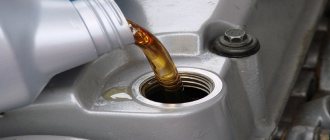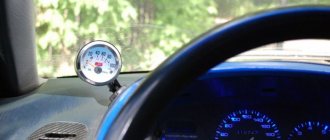a mystery to everyone! Priora engine 16 cl. No oil pressure. The block has a new cylinder head, the working one was installed, the oil was changed 4 times, the filters were also changed, the oil pump was changed 2 times, the elbow was changed, and the bearings were changed 2 times. The mechanical sensor shows 0.5-0.8 kg at idle, the sensor has been checked. It should be 2.0-2.5. The pressure disappeared after the rebuild; the engine was bought secondhand. There are no changes from all actions
Did you grind the knee? Are the oil plugs definitely all in place? My sister had such garbage on 12. They spent a long time looking for oil pressure. And they changed the liners, it didn’t help (although the mileage was considerable) the problem was solved by replacing the camshafts. On the old journals, they were very worn out. And the pressure control The oil is taken at the very last point - after the camshafts. In general, the oil flew away through the journals.
The knee was first replaced with a used one, then a new one was bought. They installed a normal cylinder head which worked properly on another engine. The engine has already been dismantled 5 times, everything is in place
The knee was first replaced with a used one, then a new one was bought. They installed a normal cylinder head which worked properly on another engine. The engine has already been dismantled 5 times, everything is in place
Clean the oil channel in the block, we had the same garbage, a piece of glue from the oil filter fell off and got into the channel that goes to the cylinder head. did the pressure appeared, the car drove for a couple of days, it disappeared again ((now I don’t know where to look... if you find it, write me in a personal message)) otherwise we’ve already removed the head 8 times and the engine 2 times, I’ll hang myself soon with this bucket! Are you sure you installed the inserts correctly?
The block was washed and blown before assembly. Then, when this garbage came out, we bought a completely new one. No changes. How dare I promise to write if the guys don’t burn the car
Clean the oil channel in the block, we had the same garbage, a piece of glue from the oil filter fell off and got into the channel that goes to the cylinder head. did the pressure appeared, the car drove for a couple of days, it disappeared again ((now I don’t know where to look... if you find it, write me in a personal message)) otherwise we’ve already removed the head 8 times and the engine 2 times, I’ll hang myself soon with this bucket! Are you sure you installed the inserts correctly?
maybe the head died due to oil starvation and pressure is lost there if there is a lot of wear on the beds or camshafts
measure the necks of the ditch and the bed. It may be necessary to grind the top cover of the ditch to fit the new ditch (make the gap nominal.
Why then did no changes occur when installing a obviously working cylinder head?
Questions regarding what is the optimal pressure value in the engine are asked by a large number of car enthusiasts, regardless of the make of the car. After all, such discussions arise only because the standard instruments installed on the instrument panel do not represent dial or graphic indicators, but only a warning lamp. It signals extreme pressure, when the car may no longer be safe to use. Thus, monitoring the state of oil pressure in real time is simply unrealistic.
Causes of poor engine pressure
There may be several reasons for this. The most common are:
- The oil level in the engine is lower than it should be, and therefore it does not completely enter the system.
This is how the oil in the editorial car was drained. Through the O-ring of the oil dipstick.
The oil pickup is cracked. Through such a crack, air enters the system, and viscous oil cannot reach components and sensors. The oil pump does not work well due to worn parts. There is oil loss in the lubrication system.
Inoperative oil filter.
The oil is diluted. A replacement is required, we have already written in more detail about the choice of oil for the 16-valve VAZ-2112 engine.
The light may also come on when the oil pressure sensor is broken or a wire has simply come off it. In this case, you need to play it safe and double-check everything.
Low engine oil level
Checking the oil level
Oil cannot be sucked into the oil pump. In this case, there will be air at the outlet. In the VAZ-2112 engine, the oil receiver is located in the lowest part of the crankcase so that it is always immersed in oil.
If you do not regularly add oil and do not control its level, this can negatively affect the operation of the engine. The oil will also lose its properties. It will not be able to wash the rubbing parts, and will also fall on them in the form of sediment. A particularly thick mixture will clog the oil receiver mesh, preventing it from sucking in full oil.
The solution in this situation is to constantly monitor the oil level and add it. It is also necessary to carry out a complete oil change in accordance with the regulations. It is not recommended to drive more than 15,000 kilometers on one oil. The oil change on the VAZ-2112 should be done every 10,000 - 15,000 km.
Car engine oil pressure
Oil pickup cracked (clogged)
Cleaning a clogged oil receiver
An oil receiver is located between the pump and the oil. When it cracks, a vacuum occurs in the tube and oil cannot enter the system. The cause of such a breakdown may be engine vibration, which results in the formation of a crack. It can increase during operation, taking less and less oil. This could also be caused by a manufacturing defect. This will require a complete replacement of the part.
We recommend: Possible malfunctions and their independent elimination on Eberspacher autonomous heaters
Oil pump failure
Oil leak from oil pump
In this option, the pump will pump less oil into the system than it may need. As a result, the pressure in the system will not be sufficient. This will be especially noticeable when starting the engine.
Losses in the lubrication system
To distribute the oil evenly between all components that require lubrication, one pump will not be enough. This will require coordinated work of other parts. Among these we can note:
- Oil nozzles.
- Crankshaft bearings.
- Gaps at the oil filter mounting location.
- Broken bushing on the balance shaft.
Oil dilution
Since liquid oil passes through all the cracks that are in the system, the pump cannot create sufficient pressure in it. Such unsuitability of the oil may occur due to the fact that it loses its performance properties. Its additives stop working, and it can additionally be diluted with gasoline.
Oil filter failure
In the context in the literal sense of the word. Look how much dirt it filtered out. Here is the answer to the question about his role!
The filter has valves and an element that cleans the oil. When the latter becomes clogged with dirt during operation, it can no longer pass oil through itself. Then the bypass valve helps him. It is normally in the closed position. When the filter becomes clogged, oil begins to flow through the valve. But if the valve hangs in the closed position, then there is nowhere for the oil to come from in the system. In this case, the engine begins to starve of oil. The way out of this situation is to timely change the oil and filter.
How to check the oil pressure in the engine and what should it be?
POSSIBLE REASONS FOR VAZ 2106, 2108, ZMZ 406, 405
But there are also reasons that may appear on specific cars, since there is another factor that influences the occurrence of the problem - the design features of the engine. For example, on carburetor engines of the same VAZ-2106 or 2108, fuel can penetrate into the sump through the fuel pump. This unit on such engines is mechanically driven by a timing belt.
And due to damage to the pump membranes, fuel will penetrate inside the engine and mix with the oil, diluting it and increasing the level. But on the ZMZ-406 engine, the cause of the pressure drop, in addition to those described, may be damage to the oil pump drive. Because of this, the unit simply will not function normally, which will affect the performance of the lubrication system.
Mechanical breakdowns inside the engine should not be discounted, as a result of which the operation of the lubrication system is affected. For example, a break in the timing chain tensioner shoe, for example, on the same VAZ-2106, will lead to the torn part starting to hit adjacent surfaces, knocking out small pieces of metal. The chips formed as a result of such a breakdown will enter the lubrication system, and then settle in the filter, leading to a drop in pressure in it. Or on the same ZMZ-405, the pump is driven through an intermediate shaft, which is driven by a timing chain. If the sprocket of this shaft breaks (it can rotate separately from it), the pump will stop working.
And there are enough such nuances. But in any case, without eliminating the cause of the malfunction, you should not use the car, so as not to end up with expensive repairs later.
Lost oil pressure? We look for and eliminate the cause. Repair VAZ 2101
Source
Engine 21126, Mystery, oil pressure periodically disappears
I have been dealing with this problem for a long time and have noticed the following patterns:
— If the oil pressure is normal and the hydraulic valves do not knock, then in city driving mode you can drive for a very long time without losing pressure, and if everything is normal with the pressure and you go on the highway, then the pressure is guaranteed to drop in the first hour of continuous driving.
— (Cold start) If the pressure is LOW, then the car starts with half a turn, and if the pressure is normal, then you won’t start the car without gas (it will sputter and stall), or you can even fill the spark plugs. If during a cold start the car starts up easily, then you are guaranteed to expect a loss of pressure, but if, on the contrary, before the cold start the oiler was blinking and when you start the car and the engine starts to work as if on one or two cylinders (until you bring it to life by accelerating), then this is guaranteed means that now the hydraulics will begin to fall silent one by one and the pressure will return :), how the engine is designed is a dark forest for me, and as I understand it, the oil pressure is unlikely to have anything to do with the engine starting, but nevertheless there is such a pattern, and if this is a coincidence , that's very strange.
How to install an oil pressure sensor on a Priora
— The pressure appears only after the engine has completely cooled down, that is, it never happened that the engine was running with low pressure and it appeared during its operation.
— When you open the oil filler cap, oil visually splashes out in the same amount, both during normal engine operation and when the oil can is blinking.
What was done: — The pressure gauge showed 0.8 when hot (but not at the moment when the oiler was flickering, but simply when the hydraulic valves were knocking) — Replacement of the oil sensor — Repeated replacement of the oil (from different manufacturers) and filter — We looked at the pan — The oil receiver mesh is clean, the liners are like new, they installed a new pump (the pressure did not change at all) - They opened the head - the bed and camshafts are in normal condition - Before opening the head, it was coated with ordinary silicone sealant which was falling apart, and not as it should - removing the oil channels, but just around the perimeter and spark plugs wells. They coated it with red loctile as required.
What could it be? Where to look? The only nuance is that when they looked at the head, they immediately said that the hydraulics were tired, but I did not change them, because when the pressure is normal they do not knock, and new ones at low pressure would probably become the same. But now I’m already inclined to believe that faulty hydraulic valves can still somehow affect the pressure?
Source
Why does engine oil pressure drop?
If you noticed a light that came on while driving on a warm engine, there is no point in starting the procedure by measuring the oil level. In any case, the dipstick will show a low content, since the lubricant still remains on the parts
Allow the oil 5-20 minutes to settle into the crankcase. The time interval from the moment the ignition is turned off until the start of measurement depends on the make of the car, air temperature, degree of engine heating, etc.
It is also important that the car is on a level surface
In the meantime, while our oil is draining, examine the surface of the engine for fresh oil stains, and check for visible damage to the oil sump. See how the oil filter feels, whether it is loose or whether its gasket is damaged. Then pull out the dipstick, wipe it dry and put it back, then take it out again. If the oil trace is near or below the minimum MIN mark, add oil to the engine. Check again with the dipstick to see if the level has risen and start the engine.
Checking the oil level in a Toyota car engine
Has the lamp gone out? What a score. The whole problem was the low lubricant content. Therefore, the device signaled to you that the oil pressure in the engine had lost. You were able to lift it, and everything fell into place.
And now briefly about other common reasons for the lack of oil pressure in the engine:
| Problem | Fixing the problem |
| Oil pump malfunction. | We buy a new one, pour a little oil into it before installing it |
| Malfunction of the sensor (measuring device). | We check the wires and the quality of the connections; - Remove the sensor and connect an external pressure gauge instead. If everything is normal, then the sensor itself has failed. It needs to be replaced. |
| Worn bearings in the motor. | We repair the engine. |
| Dirty oil filter, clogged oil channels, oil intake screen, faulty oil intake tube. | We install a new filter, clean the channels - Add engine oil - Remove the oil sump, clean the mesh, change the tube. |
| Problems or clogged pressure relief valve (liquid leaks through seals and other seals). | We disassemble the valve, clean it, and replace it if necessary. |
We recommend: The engine does not develop power: what to do?
practical guide
1. Remove the crankshaft timing belt and its key.
2. Remove the crankshaft position sensor.
3. Remove the oil intake.
4. Using a 10 mm socket wrench, unscrew the six bolts securing the oil pump to the cylinder block.
5. Remove the oil pump from the engine.
6. Remove the remnants of the sealing gasket from the mating surface of the cylinder block.
Disassembly
1. Using a 5 mm hex wrench, unscrew the six bolts holding the pump housing and cover together.
2. Separate the pump housing and the cover.
3. Remove the drive gear from the cover
4. Remove the driven gear from the housing
Recommendation
The pressure reducing (safety) valve plug is tightened with a large torque. When unscrewing it, you may accidentally damage the pump cover. Also, the turnkey edges on the cork itself are damaged. Therefore, do not disassemble the valve unless necessary. The valve can be washed without disassembling it.
5. We wash the pump parts with diesel fuel or kerosene, wipe them dry and lubricate the gears with clean engine oil.
Examination
1. Inspect the oil pump parts. They should not show signs of heavy wear, metal accumulation, cracks or other damage.
2. Using a caliper, measure the diameter of the mounting hole of the driven gear in the pump body and the thickness of the partition between the driven and driving gears.
Comment
The diameter of the driven gear seat in the pump housing should not exceed 75.1 mm. The minimum thickness of the dividing wall between the drive and driven gears is 3.4 mm.
3. Using a micrometer, measure the thickness of the driven and driving gears. If the driven gear is thinner than 7.35 mm, and the driving gear is thinner than 7.41 mm, replace the gears.
What value should it be?
To begin with, it is worth noting that pressure is measured in bars (BAR), because we are measuring liquid. It’s unlikely that anyone will tell you the exact values now, because the structures of the engines are different, but there is a certain normal interval.
AT idle speed it is 2 BAR (or 0.2 MPa), for most cars
At 4000 - 5000 rpm - this is 4.5 - 6.5 BAR (0.45 - 0.65 MPa), also for most brands
If we take our VAZ 2112 16 valve version, then the pressure at idle is slightly higher, about 1.5 - 2.5 BAR. But at 4000 - 5000 rpm 0.4 - 0.6 BAR.
Actually, I’ll end here, I think the information was useful, read our AUTOBLOG.
(4 votes, average: 2.75 out of 5)
Similar news
Why do you close the radiator in winter? Let's say with cardboard, the necessary knowledge
Mileage 100,000-150,000 km. Is it a lot or a little, what needs to be changed? Ra.
OTTO cycle. ATKINSON. MILLER. What is it, what are the differences in ra.
Comments
Good day everyone, I decided to write my review of the 2010 Toyota Avensis. Just want…
TOP articles for the month
I have many different articles and videos on various gearboxes, for example here...
I already have an article on the website about choosing memory cards (you can see it here), it’s very...
In the article - is it possible to open windows when the air conditioner is running (you can read it here), I was asked...
ADC knock sensor VAZ Priora 16 valves
I decided to create a new topic in this section, because... It simply doesn’t exist separately for this sensor.
I overcame one problem related to this sensor and decided to share. Nothing special really. There is quite a lot of information on the Internet to solve this problem. The effectiveness of this modification has simply been confirmed once again.
I have a car from the summer of 2011, one of the first SEs. Controller - BOSCH ME17.9.7 with firmware B574DB03 (complete stock, nothing flashed). For the last six months or a year I have been observing an accumulated error on the bookmaker's office. 0327
(“Low signal level of the Knock Sensor”). The check (CE) was never lit. The following anomaly was sometimes noticed behind the car - “roars, but does not drive.” The noise from the engine during dynamic acceleration was indeed somewhat unhealthy. And sometimes there is a pleasant “buzz” of the engine with excellent pickup.
I tried to crawl up to the DS (Knock Sensor) from above to check the connector for poor contact (oxidation) and try to tighten it. Removed the air filter box. My car has air conditioning (Halla). In general, I will say this, it is almost impossible. I still threw off the connector, wringing my hands quite a bit. The contacts turned out to be absolutely clean. It was difficult to put the connector in place. I tried to put a 13mm head with a 1/4 ratchet on the DD fastening bolt (the other one just wouldn’t fit there), but nothing worked. The DD is located in the solution of the crankcase ventilation tee plug and the oil dipstick - it is very difficult to get to, everything is done only by touch and on a cold engine. There was a vague hope that distorting the connector would clean it out a little and the DD contacts would go away and the error would go away. But the next trip did not confirm this - again 0327.
Okay, we will do all the manipulations from below, removing the crankcase protection (“Sheriff”).
And here, in fact, is the supposed cause of this problem (quote taken from the FAQ of the site chiptuner.ru):
| In the DD ADC channel, the voltage varies from 0.1 to 0.4 V instead of the prescribed 0.6 -1.2 V (naturally, the DD is working properly). The reason is factory sloppiness - the DD is screwed on with a screw screwed into the body of the block with an M8x20 screw, without a spring washer. Treatment - instead of a screw, screw a standard stud into the body, secure the DD with a nut, with the appropriate torque, installing a spring washer. ©Aktuator |
Before all the work, I decided to take a diagnostic look at what was going on with the standard DD. I used a USB K-Line adapter from the State (updated with special firmware for diagnostic capabilities) and the OpenDiag v1.4.0 program (the latest free version). This is what happened.
ADC DD - red graph. The first 5 minutes after starting the engine there is general silence, even when revving the gas. And only then does some activity appear. Well, and signal levels. Usually this is a little less than 0.3V, and when the speed increases, the maximum turns out to be about 0.7V - very little.
I ordered a knock sensor from BOSCH from Exist. It cost me 1042 rubles. The original arrived in a new box. Why did you take it right away? I really didn’t want to spend half a day again going to the garage, overpass, and removing the protection. +There are quite a few reviews on the Internet that the DD from BOSCH is “set and forgotten” (high reliability and better sensitivity compared to domestic DD).
I bought a hairpin M8x35 (and two + two other sizes) at BBC. But it’s better to take this hairpin or this one. Be sure to have an M8 “grower” washer and an M8 nut (13 or 14). This is how the set turned out (in the photo there are two studs that didn’t fit).
It's useful to remove the original sensor. On the 1/2 ratchet I attached a 13 socket, put it on the sensor bolt and. I pushed it without any effort at all!
This is the source of the problem. Unscrewed it and took it off. Indeed, at the factory they didn’t even put a grommet under the bolt.
Search for truth
I work in Chisinau, in a car service center. The management bought a 2014 Porsche 911 turbo S. in the back of 991.1, and later turbo S 991.2 (restyling) 2017. The cars were sunk in the USA and did not show any signs of life, after preliminary diagnostics, it turned out that there was water in the engine, which had corroded the coating of the cylinder walls. After disassembling the engine, it was decided to line the engine in a local office, they were chosen for this reason They have the best equipment in our country. After liners and replacement of all seals, piston rings and necessary threaded connections (bolts and screws), the price for both engines of these parts is comparable to the price of a brand new Renault Logan in a top-end configuration. The turbines were also replaced, because... through the exhaust and water entered the engine. The engines were assembled in accordance with the manufacturer's technical documentation, all tightening torques were observed. After a complete overhaul of the car, the engines were carefully run-in for about 3,000 km, the first oil and filter change was 500 km, the second was 1,500 km, and at the end of the run-in another change, oil according to approval, original filter. I ran the cars myself, always warmed them up, didn’t put any heavy loads on them, the gearbox was in sport mode so that it wouldn’t shift at 1,500 rpm with relatively low oil pressure, all levels and temperatures were always normal. And then, about 2000 km after the break-in, the 3rd piston knocked, when opened, scuffs were discovered in two cylinders, the pistons were smeared on the liners. We arrived with this scrap metal at the office that lined the block, they were a little shocked, and they said, you understand that this could not happen because of the sleeve, but I understand that this could not happen because of the assembly. There is no technical expertise in our city, I want to send the block and piston group to Moscow so that they can give an expert opinion and reseal the block.
It is still unknown how the second car will behave. I will soon remove the crankcase and try to use an endoscope to look at the condition of the liners.
So, while they send it, maybe there is someone here who understands all this and can express their opinion.
About additives and properties of oils for increasing pressure in the system
Some car enthusiasts are interested in whether there is motor oil that increases the pressure in the system. Rather, we are talking about special additives that improve its characteristics. The main result from the use of such compounds (for example, SUPROTEC) can be called the restoration of the previous parameters of operating processes in the engine. The surfaces of working parts and mechanisms of the piston group, worn out by constant friction, are partially restored, and their oil-holding capacity increases. As a result, fuel combustion efficiency increases and engine compression improves. Many oils contain special additives that are aimed at reducing engine lubricant consumption.
This is where we will end today’s material. There are many interesting articles ahead of us in the field of engine maintenance and car maintenance in general. Therefore, subscribe to our updates to receive useful newsletters in the future. Bye!
Source
What value should it be?
To begin with, it is worth noting that pressure is measured in bars (BAR), because we are measuring liquid. It’s unlikely that anyone will tell you the exact values now, because the structures of the engines are different, but there is a certain normal interval.
AT idle speed it is 2 BAR (or 0.2 MPa), for most cars
At 4000 - 5000 rpm - this is 4.5 - 6.5 BAR (0.45 - 0.65 MPa), also for most brands
If we take our VAZ 2112 16 valve version, then the pressure at idle is slightly higher, about 1.5 - 2.5 BAR. But at 4000 - 5000 rpm 0.4 - 0.6 BAR.
Actually, I’ll end here, I think the information was useful, read our AUTOBLOG.
Similar news
- Why do you close the radiator in winter? Let's say with cardboard, the necessary knowledge
- Mileage 100,000-150,000 km. Is it a lot or a little, what needs to be changed? Ra...
- OTTO cycle. ATKINSON. MILLER. What is it, what are the differences in...
A little history
The VAZ “ten” line dates back to the 2110 sedan (1995). Three years later, the assembly of the 2111 station wagon model was established, and a year later the production of hatchbacks began.
At first, the 2110 model was equipped with a sixteen-valve one and a half liter engine. These were the maximum capabilities of the famous automobile plant in those days.
But time passes and progress, including automotive progress, does not stand still - another car appears, VAZ-2112, 16 valve. The hitherto known eight-valve version had less dynamism and power. And the appearance of the car has become more sporty.
Oil pressure on a VAZ-2112: how much should it be?
Many motorists know that the 16-valve VAZ 2112 engine has engine compression. This is an indicator of oil pressure, which is found in all modern engines. But, for a given engine, what should this indicator be? This is exactly what this article will discuss.
Video about checking compression and oil pressure in the engine:
The video material will tell you how to correctly measure the oil pressure in the engine.
What is oil used for?
The oil pressure indicator lights up on the instrument panel
Automotive oil plays many functions in a car. Initially, this is the lubrication of parts and internal elements. So, without this, rapid wear of most spare parts is inevitable. The second function is cooling the motor elements. Oil is a good “heat absorber”, which provides additional protection against overheating.
The third function is to provide compression. This indicator gives traction power and normal functioning of the engine, namely operation at idle and at higher speeds.
What builds up oil pressure
Oil pump
To pump oil, the engine has an oil pump, which lifts oil from the sump and distributes it throughout the entire system. Thus, it not only provides lubricant, but also creates the necessary pressure. There are several factors that can cause the pressure in a car to drop:
- Unstable timing.
- Oil pump failure.
- Valves not fully closed.
- Other factors that can lead to loss of engine pressure.
What should the pressure be?
Now, directly to the question, what should be the pressure in the 16-valve VAZ 2112 engine? If you believe the manufacturer’s data, then the engine when measuring the pressure gauge should produce the following indicators:
- At idle speed - 2-2.2 bar.
- At speeds of 4-5 thousand - 5-6.5 bar.
The pressure gauge measures the oil pressure in the engine
As practice shows, most motorists have the following indications:
- At idle speed - 1.5-2 bar.
- At speeds of 4-5 thousand - 4-6 bar.
This indicator is considered normal for the complete and uninterrupted functioning of the engine, as well as ensuring the normal operation of all systems.
conclusions
When measuring a 16-valve VAZ 2112 engine, the pressure gauge shows the following indicators: idle speed - 1.8 bar; speed 4-5 thousand - 5 bar. This is quite enough for the systems to function normally and for no interruptions in engine operation.
carfrance.ru
Why can the oil pressure light come on on a warm and cold engine?
Let's start with the fact that the oil pressure indicator lamp is not an indicator of the level of the oil itself and its quality. The purpose of this device is to record oil pressure or its absence in the central line of the engine lubrication system. It turns out that the oil pressure light comes on if the pressure in the system has dropped below the permissible level.
Please note that it is normal for the oil pressure light to light up briefly (1-3 seconds) or blink after starting the engine. The fact is that the oil pump does not maintain constant pressure in the system after the engine is stopped. Oil pressure begins to build up from the moment the crankshaft is cranked by the starter. If the oil pressure light does not go out or continues to blink for a longer time after starting, then this may indicate a malfunction, low level or quality problems with the engine oil.
Why does the oil pressure light come on? Main reasons.
It should also be added that during cold periods, the engine oil in the crankcase thickens (especially mineral oil) and the oil pump takes more time to raise the pressure in the lubrication system to the required level. If the oil pressure light stays on longer than usual, then the first step is to turn off the engine and check the oil level using the dipstick or by analyzing the oil level readings on the dashboard.
You should also remember about this phenomenon when the oil pressure light comes on briefly while driving in a fully functional car. This can occur as a result of severe body roll during active driving of a vehicle with a so-called “wet” sump. To put it simply, the oil in the oil pan overflows heavily to one side of the tilt, gets agitated, and foams. All this makes it impossible for the oil pump to effectively extract and supply lubricant into the system under the required pressure. To eliminate this phenomenon and prevent negative consequences on sports rally cars that require long-term operation in such conditions (overcoming difficult obstacles, jumping, constant rolls), a dry sump system is installed. In all other cases (if the warning light is on for a longer time), the situation can be considered an emergency.
Engine oil under the required pressure must be stably supplied to loaded pairs and friction units: crankshaft and camshaft bearings, to the turbocharger rotor, to hydraulic timing valve compensators, hydraulic belt tensioners, phase shifters of the variable valve timing system, etc. The operation of such components at low pressure in the oil system leads to the formation of scuffing on the liners and journals of the crankshaft and camshaft, rapid abrasion of antifriction coatings at the interfaces of parts, overheating of loaded elements, etc. With insufficient pressure in the lubrication system, an engine is subject to severe wear and overheating; liners may rotate, shafts may jam, turbocharger failure, etc.
How to bypass the immobilizer
If a malfunction occurs in the anti-theft system, the car cannot be started with the key, the immobilizer sends a signal to the ECM to block the main systems. If the need arises to install autostart, the driver has a question about how to disable the Priora immobilizer himself.
Using a crawler
The use of an immobilizer crawler allows you to use the autostart procedure for a vehicle without dismantling or disabling the APS. You can make a device to bypass the system yourself or buy it and install it at a service station.
A simple walker consists of a relay, an inductor for pumping power to the chip, and a diode. A working key is wound to the coil, the circuit is mounted in parallel to the standard pumping coil.
Without a lineman
At the service station, a procedure is carried out to reflash the engine ECU in order to disable the immobilizer. If you have an adapter, laptop and software, you can perform this operation yourself.
To do this you need:
- Disconnect the negative cable from the battery terminal.
- Gain access to the ECM, disconnect the unit from the vehicle network.
- Remove it from the car.
- Remove the cover from the ECU, solder the resistor on the board to a position that allows reprogramming.
- Connect the board to the adapter that provides communication with the computer and supply power to it.
- Using the program, erase data from non-volatile EEPROM memory.
- Save changes, disconnect from computer.
- Resolder the resistor to its original place.
- Install the ECM into the vehicle's electronic system.
When this operation is carried out, the engine ECU stops receiving signals from the immobilizer.
Resolder the chip in the control unit
If there is no adapter and it is possible to supply power to the ECM during programming, it is recommended to unsolder the EEPROM memory chip. In its place, put a new clean chip or the same chip, but only reset it using a programmer.
Disconnect the control unit
Physically disabling and removing the immobilizer from the Lada Priora is not possible, because it is integrated into the car’s comfort unit circuit. Disabling the power supply unit will disable the vehicle.
Lost oil pressure on Priora
| ignat 93 wrote: |
| I brought the car from the service station (AvtoVAZ). As expected, there was ice in the pan. I support the oil issue, but the point is that the car is still under warranty. They blamed me - I don’t warm it up enough and don’t drive it enough - a candence will form. It seemed to warm up normally. Well, up to 60-70 somewhere. In general, they replaced the filter and oil at my expense! They made me look like an idiot. one of the workers blurted out that I was not the first in these frosts and this is also a sore on the Priors! After the 2nd maintenance, I won’t take the car to them (it’s discolored). I'll change the oil and filter myself - they seem to be crap there!! Smile, for example, on the VAZ 21103 there were never any such problems. |
Looks like this is my case too. Lukoil GENESIS ARMORTECH oil, 5W40, was poured into the Priora in the summer, the mileage on it is about 1.5 thousand. I filled it myself. Recently there were frosts, about -20, without leaving, we warmed up the car (15-20 minutes), turned it off, then didn’t start it for several days. When they started to start it, the oil pressure light began to constantly burn, and the hydraulic valves began to crackle. After removing the oil filter, when cranking with the starter (DPKV was turned off), no oil came out of the pump. When we were looking for the cause of the loss of pressure, we removed the filter and did not notice anything unusual in the oil that spilled onto the filter, the oil was like oil. I installed a new filter, and nothing was pressed through with it (as it didn’t pour out without a filter, it didn’t work) They dragged the car with a tie into a pit, into the garage
We heated the sump with a 2 kW hairdryer to see if the oil would come out when the starter was turned, and removed the filter. Before starting, all the oil that spilled onto the filter from the system was in drops of water. Then we turned the starter, oil came out. We installed the filter, started the engine and after 5-10 minutes, the hydraulics were pumped and stopped rattling.
Video
The gearbox oil should be changed every 30,000-40,000 km - if you have a manual gearbox, and 50,000-60,000 km if you have an automatic transmission. In my case, the rear gear crunching was heard and the second gear began to work hard. The dipstick showed the oil level at a minimum, although it should be between the minimum and maximum stripes. If it is below the minimum, then you should think about changing it, otherwise the parts will wear out and crumble. Choice of oil? Which one should I fill? Let's see what the manufacturer advises us:
Many people use ZIC oil (made in Korea) and other oils. Although it costs a little more, I didn’t see the point in overpaying. Now let’s look at the labeling. SAE class and winter-summer temperature range (in °C): 75w-80 – from -40 to +35° C; 75w-90 – from -40 to +35° C; 80w-85 – from -26 to + 35° C; 80w-90 – from -12 to +45° C. Here transmission lubricants were classified by quality. The letters indicate the quality and area of use of the oil, and the numbers indicate the temperature regime. The temperature limits when using synthetics increase. Since my region is northern, my temperature range ranges from -40 to +35, then either 75w-80 or 75w-90 is suitable for me. Mineral lubricants do not have this feature. When lubricants are used in the transmission, fluctuations in the physical composition begin. Oxidation of a mineral base occurs faster than a synthetic base. For this reason, the mineral base ages faster. Mineral lubricant is changed more often. Transmission devices will wear differently. So we take either semi-synthetic or synthetic, whichever you can afford. I took semi-synthetic gear oil from Rosneft 75w 90 GL4/5 with a volume of 4 liters.
What you need for work: 1. Open-end wrench size 17 (socket wrench is most convenient). Price: 125 rubles (420 tenge)2. Funnel and hose 1.0-1.5 m long (for filling oil). Price: 125 rubles (420 tenge)3. Jack (or inspection hole/overpass).4. Empty container for draining old oil (3-4 liters).5. Gear oil 4 liters. Price: 1150 rub (3900 tenge)
Before draining the oil from the gearbox, you need to warm it up. You either need to drive for 15 minutes or drive 5-10 km. Then, within 15 minutes while the oil is hot, you need to drain it. Warming up the car on the spot will not help, you definitely need to drive it. Just in case, I put the car in first gear and the handbrake. Jacked up the front wheel on the driver's side. I tightened the bolt with a 17mm wrench. I washed the bolt (so that I could insert a clean one later). I placed an empty container to drain the oil. The pressure was low and oil was poured into the protection. It’s most convenient, of course, to first remove the protection before draining the oil; I was too lazy to tighten a bunch of screws. I lowered the car from the jack and left it standing there for 30-40 minutes. Around the 20th minute, I took it off the program.
Then he jacked it up again and tightened the bolt. I wiped everything around the bolt that I was tightening with a dry rag in order to track any possible leaks, and poured oil through a hose with a funnel. After filling 3 liters, I began to periodically check the oil level with a dipstick. It took about 3.7-3.8 liters of oil. You need to fill in a little more than the strip at maximum so that the fifth gear does not dry out. I wiped the dirt off the dipstick with water and put it in place. I got into the car and started turning the gears 3-5 times, so that the oil would seep out normally everywhere. After this procedure, the box began to work softer and the sounds became less.
Replacement procedure
All work on replacing the controller must be carried out on a cooled engine, since during operation the lubricant heats up to high temperatures. Dismantling procedure step by step.
- Remove the negative terminal from the battery.
- The sensor is located in a hard-to-reach place; for convenience, you can remove the air filter.
- Remove the wire plug, inspect the connector, check the wiring. In 20% of cases, breakdowns are caused by frayed wires.
- Using a 21 key, loosen the controller fasteners.
- Unscrew from the seat. Check the tightness of the seat ring that is in the socket and replace if necessary.
- Install the new controller in reverse order.
Replacing the pressure sensor on a Priora will require 10 minutes of work in the garage, but if the malfunction of the indicator is associated with a wiring breakdown, the car needs to be fully tested and the contacts cleaned. If you are concerned that your experience is not enough, it is better to contact the service.
Where is
In the LADA Priora car, the automatic anti-theft system (APS) is structurally built into the electrical package unit (comfort unit). Depending on the year of manufacture of the car, its location may be different. In early Priora models, it was located under the center console (beard), which is located in the middle of the dashboard. Under the electrical package unit in these models there was an electronic engine control system (ECM) or an electronic control unit (ECU).
In subsequent modifications of the Lada Priora car, the comfort unit, in which the immobilizer is located, was placed on the left side of the mounting block by the designers. The latter contains relays and fuses. Due to the fact that the electrical package unit is fixed to the surface of the body, behind the mounting block, it is difficult to get to it.
According to factory technology, to dismantle the comfort unit, it is necessary to disassemble part of the instrument panel, which is long and difficult. But there is another way:
- Before performing any operations on the vehicle's electrical equipment, be sure to remove the contact terminal from the negative electrode of the battery. Remove the plastic panel from under the steering wheel by unlocking the mounting fasteners.
- The mounting block becomes visible, behind it the assembly with the immobilizer is screwed in a perpendicular position. Blindly, use your hands to approach the 3 wiring connectors of the electrical package unit and disconnect them.
- Using a bell wrench with a working head of 10, unscrew the 2 mounting bolts that hold the electrical package unit by touch. The bolts are not visible, they are located behind the fuse box.
- Carefully remove the assembly; it can only be removed in one position.
Check and replacement
During operation of the VAZ-2112, various malfunctions may occur. For example, the oil pressure sensor may fail. However, before drawing conclusions about the causes or presence of a possible breakdown, you should first check the functionality of the device.
The check is performed as follows:
- First of all, check the circuit connecting the DDM and the control lamp. To do this, take the sensor wire and lean it against the surface of the engine. At the same time as this action, you should see if the light on the dashboard is on. If the lamp goes out, then the wiring is fine and the problem is really in the sensor.
- The next step is to remove the device from the vehicle for a visual inspection. The first sign of a breakdown is the presence of moisture on the sensor.
If the DDM turns out to be dry and everything is in order with the wiring, it is recommended to look for the problem elsewhere. For example, the malfunction may be in the oil level or its quality. You can also replace the oil filter if necessary.
There is another way to check the functionality of the sensor in the VAZ-2112. It is considered more reliable and proven. In this case, you will need to use a pressure gauge, and the sequence of actions will look like this:
- First of all, it is necessary to warm up the engine until it reaches operating temperature, and then turn it off.
- Next, you need to unscrew the sensor from the car and screw in the pressure gauge in its place.
- The ground wire of the pressure gauge will need to be connected to the ground of the vehicle.
- After this, you need to connect the control LED to the battery.
- The next action is to turn on the engine and press the gas pedal. In this case, it is necessary to take into account that the speed rises gradually.
When the action is completed, you should carefully monitor the pressure gauge and LED. If the device readings reach 1.2 and 1.6 bar, but the LED does not go out, then the sensor is faulty and needs to be replaced.
To carry out the replacement you will need:
- Stock up on the necessary tools, as well as a new sensor.
- Disconnect the wires from the old device.
Unscrew the sensor using a wrench.
Remove the unit
In this case, during the dismantling process, you should pay attention to the fact that the sealing ring should come out along with the sensor. It will also need to be replaced
- Install a new sensor.
- Check the contacts and clean them if necessary, then connect the wires.
When all the steps are completed, you can start the engine again and check the serviceability of the sensor.
Alarm indication
Of course, now in almost all cars there is an emergency indication for a complete lack of pressure, this is known to us all - a “burning oil can”. If it doesn’t go out for some time after starting, for example 10 – 20 seconds is one thing, it’s almost always the oil filter’s fault . But if the lamp is constantly on, then this is already an alarm bell. Perhaps the oil pressure sensor has simply failed, or perhaps the oil pump has failed.
In any case, the emergency indication is very important, and I do not advise you to joke with it; nevertheless, this is fraught with a major engine overhaul .
Remember this rule, if the lamp comes on, then turn off the car and preferably immediately to a service station, either a tow truck, or in tow.
In what cases is it necessary to replace motor lubricant?
The performance of the power unit and the operation of the vehicle itself will depend on the characteristics of the lubricant and its quality. The manufacturer installed several different engines on the Priora, ranging from 8-valve 21114 and 21116 to 21126–21128. They already have 16 valves and are capable of producing power up to 120 hp.
According to the recommendations provided by the manufacturer, oil changes must be carried out in strict accordance with the regulations. For new cars, as well as for those that have undergone major engine repairs, this should be done after 2.5 - 3 thousand kilometers. When should you change the lubricant afterwards? Everything is very simple here - during further operation you will have to replace it every 15 thousand kilometers or annually, without regard to mileage.
However, these are not all situations that affect oil consumption and the need to change it. Manufacturers say that the engine can consume up to 1 liter of lubricant literally for every 1000 kilometers traveled. This is a common occurrence, especially for domestic engines, but a more accurate consumption rate depends on the characteristics of the oil, for example, its viscosity, as well as operating conditions. When driving at high speeds, frequent accelerations, and also when the engine has not been run-in, the degree of consumption will be an order of magnitude higher.
